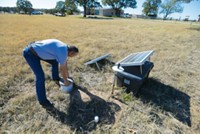Advertisement
Grab your lab coat. Let's get started
Welcome!
Welcome!
Create an account below to get 6 C&EN articles per month, receive newsletters and more - all free.
It seems this is your first time logging in online. Please enter the following information to continue.
As an ACS member you automatically get access to this site. All we need is few more details to create your reading experience.
Not you? Sign in with a different account.
Not you? Sign in with a different account.
ERROR 1
ERROR 1
ERROR 2
ERROR 2
ERROR 2
ERROR 2
ERROR 2
Password and Confirm password must match.
If you have an ACS member number, please enter it here so we can link this account to your membership. (optional)
ERROR 2
ACS values your privacy. By submitting your information, you are gaining access to C&EN and subscribing to our weekly newsletter. We use the information you provide to make your reading experience better, and we will never sell your data to third party members.
Environment
Hydraulic Fracturing Shake-ups
September 2, 2013
| A version of this story appeared in
Volume 91, Issue 35
“Shaking Up the Fracking Debate” gives the impression that earthquakes near hydraulic fracturing wells are due to earthquakes at distant locations (C&EN, July 15, page 8).
That may be true for some locations, but in Denver we had a deep well at the Rocky Mountain Arsenal in the early 1960s. After that well was put into use, earthquakes happened in the Denver area. Property damage occurred, but no one was killed. The epicenter of those quakes was determined to be the well at the Rocky Mountain Arsenal. The well was shut down in 1966, and all the quakes subsided and have since disappeared. Distant earthquakes or not, the well at the Rocky Mountain Arsenal was responsible for the quakes.
Let us be sure to hold accountable the oil companies that engage in fracking for the earthquakes that they cause—like the one that hit Prague, Okla., and leveled 14 homes in an otherwise seismically quiet area.
Perhaps we should rethink how fracking will provide safe and abundant energy. It may not be as safe as we would like it to be.
Robert T. Anselmi
Littleton, Colo.
I submit that an alternative method of retrieving shale gas can be used (see U.S. Patent No. 8,262,167 and No. 8,408,658).
The method uses an underground ventilated control center wherein computer-controlled horizontal drilling is used in multiple directions. The center can be located in the middle of an underground shale deposit. Drilling operations can be conducted for distances of up to a mile or more. Unlike with fracking, pressurized water, hazardous chemicals, and solid proppants are not used. After mining operations are complete, the drilled-out spaces are not abandoned. Waste material from aboveground is transported and placed in the cylindrical spaces. It is envisioned that the waste material will become a source of methane and other valuable chemicals for years into the future.
Leander F. Aulisio
Lakeland, Fla.



Join the conversation
Contact the reporter
Submit a Letter to the Editor for publication
Engage with us on Twitter